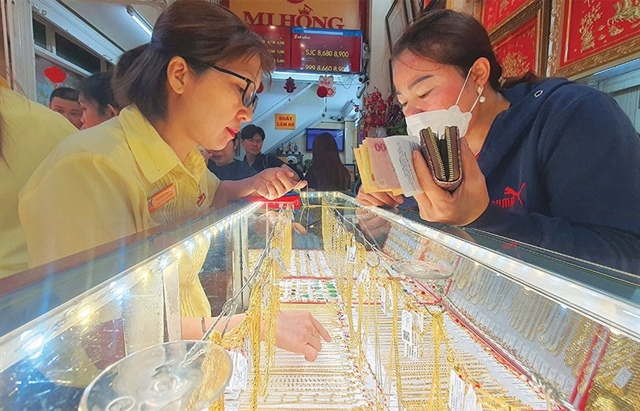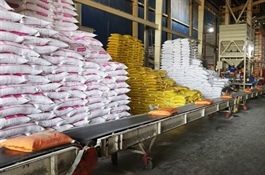Gold reinforces status as safe-haven asset
Gold reinforces status as safe-haven asset
Global gold prices are surging to new records amid trade war fears, pushing domestic prices past last year’s peak.
On February 6, global spot gold prices surged by more than $20 per ounce during the trading session, briefly reaching a new all-time high of $2,882 per ounce. The price then slightly retreated but remained above the $2,870 per ounce level.

Gold reinforces status as safe-haven asset, Photo Le Toan |
Heng Koon How, head of Market Strategy at UOB Bank Singapore, expects gold prices to remain strong, citing robust safe-haven demand amid rising geopolitical and economic risks.
“Geopolitical factors such as US-China trade tensions and shifts in global supply chains will continue to influence gold prices. Investors seeking safe-haven assets are increasingly turning to gold,” he said.
Global gold demand has hit record highs amid heightened investor concerns over potential global instability. Global demand increased by 1 per cent in 2024, reaching a record high of 4,974.5 tonnes, driven by rising investments and central bank purchases. Gold prices also surged by 27 per cent, marking the largest annual increase since 2010, as economic uncertainties and lower interest rates bolstered demand, according to the World Gold Council’s (WGC) Gold Demand Trends report for 2024, released on February 5.
Louise Street, senior market analyst at the WGC, attributed this trend to the onset of interest rate-cutting cycles by several central banks and escalating geopolitical instability, including the US presidential election and tensions in the Middle East.
“In 2025, we expect central banks to maintain a dominant role in the gold market, while gold-backed exchange-traded funds are likely to attract more investors, particularly as interest rates decline. However, volatility will persist.”
Conversely, jewellery demand may continue to decline as high gold prices and weak economic growth erode consumers’ purchasing power. Geopolitical and macroeconomic uncertainties will likely remain prevalent this year, further increasing gold’s appeal as a store of wealth and a risk-hedging asset, added Street.
Beyond trade tensions, uncertainty surrounding the US Federal Reserve’s monetary policy has also contributed to gold’s price surge.
Although a strong US dollar typically suppresses gold prices, analysts believe that concerns over its tariff policies have driven increased safe-haven demand for gold.
Federal Reserve chairman Jerome Powell signalled that the Fed is “in no rush to cut interest rates”, contradicting President Donald Trump’s calls for lower rates. This divergence has added to uncertainty, making gold an increasingly attractive investment.
Exchange rates rebounded on February 7 following a sharp increase on the first working day after the Lunar New Year holiday. The State Bank of Vietnam (SBV) set the central exchange rate at 24,462 VND/USD, an increase of VND37 from the previous day’s rate.
“The US dollar’s strength is expected to remain dominant in the first half of 2025. Currently, US interest rates are around 4.5 per cent, and according to UOB’s forecast, a 50-basis-point cut would bring the rate down to 4 per cent, which remains relatively high,” said Dinh Duc Quang, head of Global Markets at UOB Vietnam.
In Vietnam, gold prices have mirrored global trends following the reopening of markets after the Lunar New Year holiday. After three consecutive days of gains, driven by surging global gold prices, domestic gold prices soared past $3,775 per tael before slightly retreating to $3,733 per tael.
Market volatility has also intensified, with gold retailers widening the bid-ask spread to as much as $125 per tael, up from around $83 earlier in the week. On February 7, God of Wealth Day, gold prices were adjusted slightly higher, with gold bars quoted at $3,750 per tael at selling price. Plain gold rings were priced at $3,729 per tael, with Doji gold rings even reaching the $3,750 per tael mark.
Beyond short-term price movements, Vietnamese investors are closely watching proposed amendments to Decree No.24/2012/ND-CP on gold market management, which the SBV is expected to submit to the government in Q2, no later than June.
Prior proposals from the Vietnam Gold Trader Association (VGTA) and financial experts have included licensing non-physical gold trading options and improving the supply of raw gold to meet domestic demand.
Huynh Trung Khanh, vice chairman of the VGTA, also views gold as an attractive investment this year but believes the room for further domestic price increases is limited compared to 2024. He noted that last year’s record gold rally was fuelled by three key factors: US interest rate cuts, escalating geopolitical tensions, and strong central bank purchases.
“Vietnam’s gold market faces an inherent supply-demand imbalance. Historically, sharp price increases trigger buying frenzies, while rapid declines lead to panic selling. Given the country’s limited gold supply, domestic prices tend to experience stronger fluctuations than global prices, depending on market conditions,” added Khanh.
























